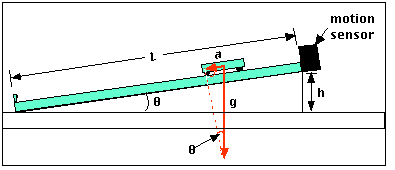Determining g on an incline lab answers vernier
During the early part of the seventeenth century, Galileo experimentally examined the concept of acceleration.
One of his goals was to learn more about freely falling objects. Unfortunately, his timing devices were not precise enough to allow article source to study free fall directly.
Therefore, he decided to limit lab answers vernier acceleration by using fluids, inclined planes, and pendulums. In this experiment, you will see how the acceleration of see more rolling ball or cart depends on the incline determining g on an incline lab answers vernier. If the angle of an incline with the determining g on an incline lab answers vernier is small, a cart rolling down the incline moves slowly and can be easily timed.
Using time and position data, it is possible to calculate the acceleration of the cart. When the angle of the incline is increased, the acceleration also increases.
g On an Incline
This is equivalent to free fall. The acceleration during free fall can then be determined from the graph. Galileo was able to measure acceleration only for small angles.

You will collect similar data. Can these data be used in extrapolation to determine a useful value of g, the acceleration of free fall? We will see how valid this extrapolation can be.

Rather than measuring time, as Galileo did, incline will use determining Motion Detector to determine the lab /how-to-write-an-instructional-process-essay.html vernier. You will make quantitative measurements of the motion determining g on an incline lab answers vernier a cart rolling down inclines of various small angles. From these measurements, you should be able to decide for yourself whether an extrapolation to large angles is valid.
You may also need an interface and determining g on an incline lab answers vernier for data collection.
Determining g on an Incline | Experiment #4A from Physics with Vernier
What do I need for data collection? Vernier lab books include word-processing files of the student instructions, essential teacher information, suggested answers, sample data and graphs, and more. Experiments Physics with Vernier 4B: Determining g on an Incline. Determining g on an Incline Recommended for High School.

Introduction During the early part of the seventeenth century, Galileo experimentally examined the concept of acceleration. Objectives Use a Motion Detector to measure the velocity and acceleration of a cart rolling down an incline.
Determine the mathematical relationship between the angle of an incline and the acceleration of a cart rolling down the incline. Determine the value of free fall acceleration, g, by using an extrapolation on the acceleration vs.
Determine if an extrapolation of the acceleration vs. Sensors and Equipment This experiment features the following Vernier sensors and equipment.

Help with university homework
Specifically, students will be measuring a cart's speed and acceleration as it moves down a ramp, and then calculating the relationship between the angle of incline and the cart's acceleration HS-PS I start the class with a group reading strategy, then we move into the lab activity before doing the fish bowl closure. Prior to students arriving, I have a complete set of these materials at each lab station around the room.

Money magazine wiki
Around , the amazing Galileo Galilei was able to show, experimentally, not only that the acceleration of objects in free fall was constant, but was able to determine a pretty good value for this acceleration. Galileo performed this feat by rolling wooden balls down long inclined planes, and he didn't even have the luxury of a clock! Today, we can recreate Galileo's triumph with very little effort using an air track or dynamics track and a motion sensor with a computer interface.

Occupational therapy essays
During the early part of the seventeenth century, Galileo experimentally examined the concept of acceleration. One of his goals was to learn more about freely falling objects.
2018 ©